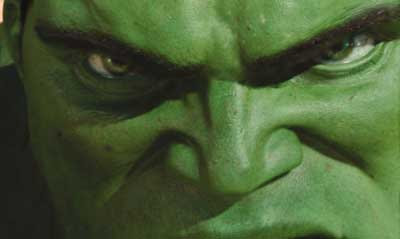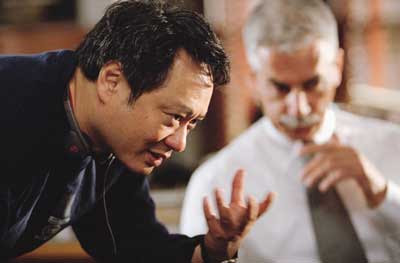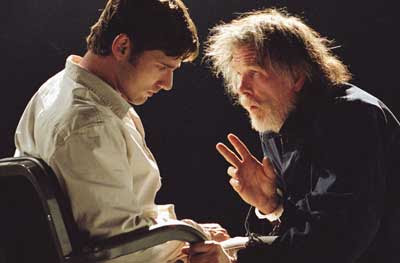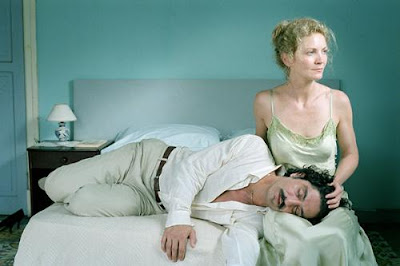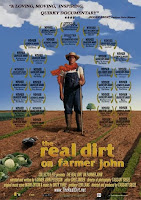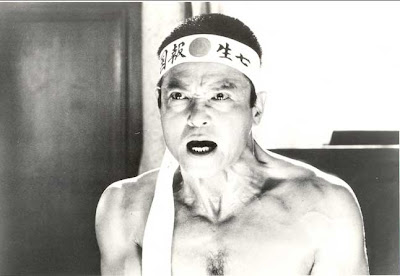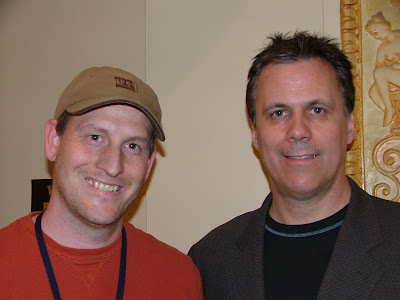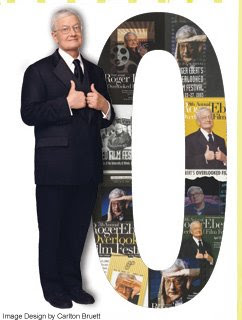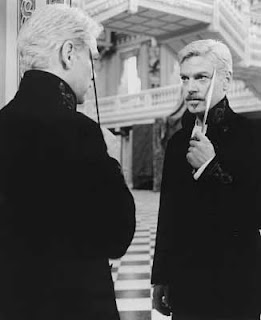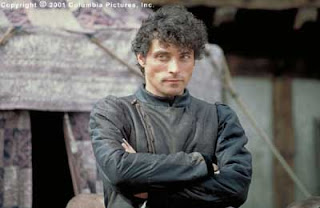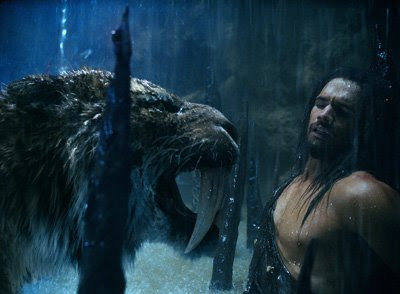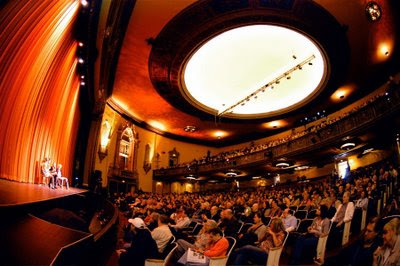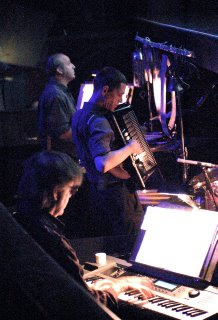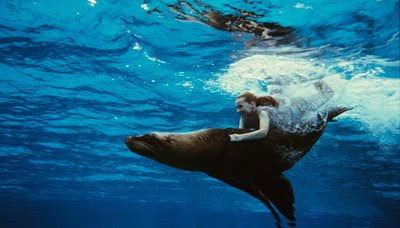All things must pass. And it is with the same melancholia that began this year’s Ebertfest that I say goodbye to it once again. Driving home from Champaign was like leaving a good friend.
 This year’s program of movies was like a series of gifts that are given only by a good friend who knows you well. Which gift was my favorite? Was it the lush words of Shakespeare, preserved uncut in Kenneth Branagh’s visually lush 70mm version of “Hamlet”? Or could it have been Steve Buscemi’s endless acting gifts on display in Tom DiCillo’s “Delirious”? Perhaps it was the lush poetry of lust in Sally Potter’s utterly original “Yes”. Or the gifts of love above all obstacles in Joseph Greco’s portrait of a family surviving schizophrenia in “Canvas”. Maybe it was the subtly beautiful landscapes and life in Jeff Nichols’ first film “Shotgun Stories”. Or the silent depths of “Underworld” given vital life through the music of the Alloy Orchestra. Possibly the quirky realities of the extraordinary life of a man who doesn’t quite fit in his surroundings in the documentary “The Real Dirt on Farmer John”. Or it might have been the oddly layered presentation of a life lived just as oddly in Paul Schrader’s masterpiece “Mishima: A Life in Four Chapters”.
This year’s program of movies was like a series of gifts that are given only by a good friend who knows you well. Which gift was my favorite? Was it the lush words of Shakespeare, preserved uncut in Kenneth Branagh’s visually lush 70mm version of “Hamlet”? Or could it have been Steve Buscemi’s endless acting gifts on display in Tom DiCillo’s “Delirious”? Perhaps it was the lush poetry of lust in Sally Potter’s utterly original “Yes”. Or the gifts of love above all obstacles in Joseph Greco’s portrait of a family surviving schizophrenia in “Canvas”. Maybe it was the subtly beautiful landscapes and life in Jeff Nichols’ first film “Shotgun Stories”. Or the silent depths of “Underworld” given vital life through the music of the Alloy Orchestra. Possibly the quirky realities of the extraordinary life of a man who doesn’t quite fit in his surroundings in the documentary “The Real Dirt on Farmer John”. Or it might have been the oddly layered presentation of a life lived just as oddly in Paul Schrader’s masterpiece “Mishima: A Life in Four Chapters”.
It is entirely possible the best part of Ebertfest 10 was the surprisingly fresh and original musical “Romance & Cigarettes” about adultery in modern day New Jersey. John Turtoro’s splendidly funny and surprisingly touching movie about a blue collar man living with his wife and four grown daughters who is caught in a fling with a sexpot mistress brings to mind the original title of Ebertfest, Roger Ebert’s Overlooked Film Festival. “Romance & Cigarettes” is a perfect example of why a film festival devoted to overlooked films is necessary.
There is no good reason why so few people have ever seen or even heard of this vital masterpiece in which regular everyday people occasionally break out into song. The film utilizes pop songs from the past few decades to explore the emotional depths of these people whom we all know. The effect of this seemingly strange premise is also surprisingly familiar. It gave me the feeling of those moments in life when something reminds me of a song and I start singing it in my head. These people just let it out to hilarious effect. Just picture James Gandolfini (Tony Soprano of HBO’s “The Sopranos”) dancing in the streets with garbage men and utility workers while singing a lover’s lament; or Christopher Walken crooning “Delilah” to a fantasy recreation of murderous revenge against a cheating lover. Tell me that doesn’t sound like a good time.
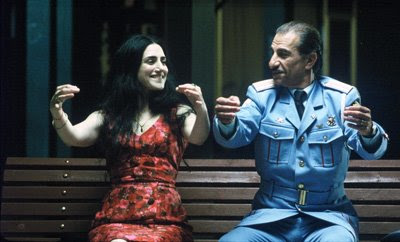 But then the Israeli film “The Band’s Visit” is like a gem buried in the sands of the desert, only to be uncovered by an unexpected gust of wind. Perhaps the polar opposite of the histrionics of a movie like “Romance & Cigarettes”, “The Band’s Visit” is a subtle, human comedy that—in its own way—is just as funny as a musical with dancing garbage men. It follows an Egyptian policemen’s band that gets on the wrong bus during a commissioned trip to Israel and ends up in a town that is devoid of almost anything.
But then the Israeli film “The Band’s Visit” is like a gem buried in the sands of the desert, only to be uncovered by an unexpected gust of wind. Perhaps the polar opposite of the histrionics of a movie like “Romance & Cigarettes”, “The Band’s Visit” is a subtle, human comedy that—in its own way—is just as funny as a musical with dancing garbage men. It follows an Egyptian policemen’s band that gets on the wrong bus during a commissioned trip to Israel and ends up in a town that is devoid of almost anything.
Considered a frontrunner for a foreign language Academy Award nomination last year, the movie was sadly disqualified because too much of the dialogue was in English. When you have characters from Egypt and characters from Israel, they’re going to have to find a common language. The real language they find is empathy. The Israelis have “no culture” in their small town. The police band exists only to provide culture. But here they are in a situation where they are all just people. The town has no hotel, so the band members must bunk with a couple of the residents. Some welcome something different, others are more resistant. But the band members find some common ground with some of the locals who seem so different at first. There isn’t a mean bone in this film.
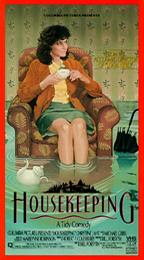 Bill Forsyth’s “Housekeeping” on the other hand, while not an overbearing or heavy story in any way, shows how our society resists different lifestyles. The story follows two sisters growing up in the 1950s. When their mother commits suicide they come under the care of their aunt, an oddball who operates under her own set of rules. One sister is embarrassed by her aunt’s behavior, while the other is attracted to the freedom of mind exhibited by her elder.
Bill Forsyth’s “Housekeeping” on the other hand, while not an overbearing or heavy story in any way, shows how our society resists different lifestyles. The story follows two sisters growing up in the 1950s. When their mother commits suicide they come under the care of their aunt, an oddball who operates under her own set of rules. One sister is embarrassed by her aunt’s behavior, while the other is attracted to the freedom of mind exhibited by her elder.
The movie breaks it own rules of what is expected by not providing some sort of structure of life lessons to be learned from this strange relative, but merely observes how the quiet mining town in which this family lives can’t find a way to accept the notion that some people are just different. I had a little trouble with this one because there were some issues of safety that are skirted around by the filmmakers. Some of the aunt’s actions clearly place herself, her nieces, and potentially other people in danger; but this is never fully faced by the filmmakers in the story they have designed. Their story has the freedom with which we should all approach something like the magic of movies, but as a way of life I fear there is a degree of respect to our surroundings that merits just a little bit of conformity.
 “The Cell” is a visual masterpiece that launched the feature film career of director Tarsem Singh, whose next film “The Fall” is due out in the next couple of weeks. I have described it as like “The Silence of the Lambs” on a massive hallucinogenic trip. It is a crime thriller, a mystery, a sci-fi flick, and a visual cocktail. While there is perhaps a little too much chewed off here for Singh to fully pull off, the parts he gets right are the ones that are the most revolutionary.
“The Cell” is a visual masterpiece that launched the feature film career of director Tarsem Singh, whose next film “The Fall” is due out in the next couple of weeks. I have described it as like “The Silence of the Lambs” on a massive hallucinogenic trip. It is a crime thriller, a mystery, a sci-fi flick, and a visual cocktail. While there is perhaps a little too much chewed off here for Singh to fully pull off, the parts he gets right are the ones that are the most revolutionary.
The story involves a new procedure which allows a psychologist, played by Jennifer Lopez, to enter into the thoughts of her patient through virtual reality technology. When the FBI catches a sociopathic killer who serendipitously falls into a coma, the psychologist must enter his mind to find the location of his final victim before the trap he has set for her springs. While the crime thriller story is effective and ingenious in its setup, it feels not quite fully fleshed out. But this is to allow the filmmakers time to spend in the psyche of the killer, which is a world of amazing visuals with lavish sets and outrageous costumes. The journey inside the mind is a trip that won’t likely be forgotten by any of the film’s viewers.
 But maybe the best part of Ebertfest isn’t the films at all. Perhaps it is the environment of being at a gathering of film enthusiasts who each bring a unique and passionate perspective on the films watched there. I was lucky enough to have a short chat with Michael Phillips, film critic for the Chicago Tribune and fill-in host for Roger Ebert in the balcony for the show “At the Movies with Ebert & Roeper”. Having met Richard Roeper just a few days prior, this completed my “At the Movies” set for this year.
But maybe the best part of Ebertfest isn’t the films at all. Perhaps it is the environment of being at a gathering of film enthusiasts who each bring a unique and passionate perspective on the films watched there. I was lucky enough to have a short chat with Michael Phillips, film critic for the Chicago Tribune and fill-in host for Roger Ebert in the balcony for the show “At the Movies with Ebert & Roeper”. Having met Richard Roeper just a few days prior, this completed my “At the Movies” set for this year.
Phillips was the most eager person I met during the festival when it came to talking about watching the movies. The Virginia Theater is one of the few classic theater houses left in the country where there is a mezzanine level and a vast balcony as well. I always feel claustrophobic in the mezzanine of the theater, so I watch all the films from the balcony. I had noticed Phillips up there for a couple of screenings as well, while most of Roger’s guests watch from the mezzanine. When he said “Hello” to me in the lobby, I thought it was the perfect opportunity to ask him about his solo outings in the balcony.
While he didn’t commit to preferring the balcony, he expressed an eagerness to experience film in every way he could. And the way he watched the movies from several different places in the theater struck me as a good metaphor for what the festival was really about. It isn’t just about seeing some of Roger’s personal favorite films or even witnessing overlooked films, genres and formats. This film festival—with its wide ranging subject matter and guests from every different spectrum of the industry—was about finding different perspectives on film, comparing and contrasting them, and appreciating this medium of magic to its utmost. It is an honor for me to try to pass on what film means to me to my readers, and to help create a deeper meaning to others for it.
 This year’s program of movies was like a series of gifts that are given only by a good friend who knows you well. Which gift was my favorite? Was it the lush words of Shakespeare, preserved uncut in Kenneth Branagh’s visually lush 70mm version of “Hamlet”? Or could it have been Steve Buscemi’s endless acting gifts on display in Tom DiCillo’s “Delirious”? Perhaps it was the lush poetry of lust in Sally Potter’s utterly original “Yes”. Or the gifts of love above all obstacles in Joseph Greco’s portrait of a family surviving schizophrenia in “Canvas”. Maybe it was the subtly beautiful landscapes and life in Jeff Nichols’ first film “Shotgun Stories”. Or the silent depths of “Underworld” given vital life through the music of the Alloy Orchestra. Possibly the quirky realities of the extraordinary life of a man who doesn’t quite fit in his surroundings in the documentary “The Real Dirt on Farmer John”. Or it might have been the oddly layered presentation of a life lived just as oddly in Paul Schrader’s masterpiece “Mishima: A Life in Four Chapters”.
This year’s program of movies was like a series of gifts that are given only by a good friend who knows you well. Which gift was my favorite? Was it the lush words of Shakespeare, preserved uncut in Kenneth Branagh’s visually lush 70mm version of “Hamlet”? Or could it have been Steve Buscemi’s endless acting gifts on display in Tom DiCillo’s “Delirious”? Perhaps it was the lush poetry of lust in Sally Potter’s utterly original “Yes”. Or the gifts of love above all obstacles in Joseph Greco’s portrait of a family surviving schizophrenia in “Canvas”. Maybe it was the subtly beautiful landscapes and life in Jeff Nichols’ first film “Shotgun Stories”. Or the silent depths of “Underworld” given vital life through the music of the Alloy Orchestra. Possibly the quirky realities of the extraordinary life of a man who doesn’t quite fit in his surroundings in the documentary “The Real Dirt on Farmer John”. Or it might have been the oddly layered presentation of a life lived just as oddly in Paul Schrader’s masterpiece “Mishima: A Life in Four Chapters”.It is entirely possible the best part of Ebertfest 10 was the surprisingly fresh and original musical “Romance & Cigarettes” about adultery in modern day New Jersey. John Turtoro’s splendidly funny and surprisingly touching movie about a blue collar man living with his wife and four grown daughters who is caught in a fling with a sexpot mistress brings to mind the original title of Ebertfest, Roger Ebert’s Overlooked Film Festival. “Romance & Cigarettes” is a perfect example of why a film festival devoted to overlooked films is necessary.
There is no good reason why so few people have ever seen or even heard of this vital masterpiece in which regular everyday people occasionally break out into song. The film utilizes pop songs from the past few decades to explore the emotional depths of these people whom we all know. The effect of this seemingly strange premise is also surprisingly familiar. It gave me the feeling of those moments in life when something reminds me of a song and I start singing it in my head. These people just let it out to hilarious effect. Just picture James Gandolfini (Tony Soprano of HBO’s “The Sopranos”) dancing in the streets with garbage men and utility workers while singing a lover’s lament; or Christopher Walken crooning “Delilah” to a fantasy recreation of murderous revenge against a cheating lover. Tell me that doesn’t sound like a good time.
 But then the Israeli film “The Band’s Visit” is like a gem buried in the sands of the desert, only to be uncovered by an unexpected gust of wind. Perhaps the polar opposite of the histrionics of a movie like “Romance & Cigarettes”, “The Band’s Visit” is a subtle, human comedy that—in its own way—is just as funny as a musical with dancing garbage men. It follows an Egyptian policemen’s band that gets on the wrong bus during a commissioned trip to Israel and ends up in a town that is devoid of almost anything.
But then the Israeli film “The Band’s Visit” is like a gem buried in the sands of the desert, only to be uncovered by an unexpected gust of wind. Perhaps the polar opposite of the histrionics of a movie like “Romance & Cigarettes”, “The Band’s Visit” is a subtle, human comedy that—in its own way—is just as funny as a musical with dancing garbage men. It follows an Egyptian policemen’s band that gets on the wrong bus during a commissioned trip to Israel and ends up in a town that is devoid of almost anything.Considered a frontrunner for a foreign language Academy Award nomination last year, the movie was sadly disqualified because too much of the dialogue was in English. When you have characters from Egypt and characters from Israel, they’re going to have to find a common language. The real language they find is empathy. The Israelis have “no culture” in their small town. The police band exists only to provide culture. But here they are in a situation where they are all just people. The town has no hotel, so the band members must bunk with a couple of the residents. Some welcome something different, others are more resistant. But the band members find some common ground with some of the locals who seem so different at first. There isn’t a mean bone in this film.
 Bill Forsyth’s “Housekeeping” on the other hand, while not an overbearing or heavy story in any way, shows how our society resists different lifestyles. The story follows two sisters growing up in the 1950s. When their mother commits suicide they come under the care of their aunt, an oddball who operates under her own set of rules. One sister is embarrassed by her aunt’s behavior, while the other is attracted to the freedom of mind exhibited by her elder.
Bill Forsyth’s “Housekeeping” on the other hand, while not an overbearing or heavy story in any way, shows how our society resists different lifestyles. The story follows two sisters growing up in the 1950s. When their mother commits suicide they come under the care of their aunt, an oddball who operates under her own set of rules. One sister is embarrassed by her aunt’s behavior, while the other is attracted to the freedom of mind exhibited by her elder.The movie breaks it own rules of what is expected by not providing some sort of structure of life lessons to be learned from this strange relative, but merely observes how the quiet mining town in which this family lives can’t find a way to accept the notion that some people are just different. I had a little trouble with this one because there were some issues of safety that are skirted around by the filmmakers. Some of the aunt’s actions clearly place herself, her nieces, and potentially other people in danger; but this is never fully faced by the filmmakers in the story they have designed. Their story has the freedom with which we should all approach something like the magic of movies, but as a way of life I fear there is a degree of respect to our surroundings that merits just a little bit of conformity.
 “The Cell” is a visual masterpiece that launched the feature film career of director Tarsem Singh, whose next film “The Fall” is due out in the next couple of weeks. I have described it as like “The Silence of the Lambs” on a massive hallucinogenic trip. It is a crime thriller, a mystery, a sci-fi flick, and a visual cocktail. While there is perhaps a little too much chewed off here for Singh to fully pull off, the parts he gets right are the ones that are the most revolutionary.
“The Cell” is a visual masterpiece that launched the feature film career of director Tarsem Singh, whose next film “The Fall” is due out in the next couple of weeks. I have described it as like “The Silence of the Lambs” on a massive hallucinogenic trip. It is a crime thriller, a mystery, a sci-fi flick, and a visual cocktail. While there is perhaps a little too much chewed off here for Singh to fully pull off, the parts he gets right are the ones that are the most revolutionary.The story involves a new procedure which allows a psychologist, played by Jennifer Lopez, to enter into the thoughts of her patient through virtual reality technology. When the FBI catches a sociopathic killer who serendipitously falls into a coma, the psychologist must enter his mind to find the location of his final victim before the trap he has set for her springs. While the crime thriller story is effective and ingenious in its setup, it feels not quite fully fleshed out. But this is to allow the filmmakers time to spend in the psyche of the killer, which is a world of amazing visuals with lavish sets and outrageous costumes. The journey inside the mind is a trip that won’t likely be forgotten by any of the film’s viewers.
 But maybe the best part of Ebertfest isn’t the films at all. Perhaps it is the environment of being at a gathering of film enthusiasts who each bring a unique and passionate perspective on the films watched there. I was lucky enough to have a short chat with Michael Phillips, film critic for the Chicago Tribune and fill-in host for Roger Ebert in the balcony for the show “At the Movies with Ebert & Roeper”. Having met Richard Roeper just a few days prior, this completed my “At the Movies” set for this year.
But maybe the best part of Ebertfest isn’t the films at all. Perhaps it is the environment of being at a gathering of film enthusiasts who each bring a unique and passionate perspective on the films watched there. I was lucky enough to have a short chat with Michael Phillips, film critic for the Chicago Tribune and fill-in host for Roger Ebert in the balcony for the show “At the Movies with Ebert & Roeper”. Having met Richard Roeper just a few days prior, this completed my “At the Movies” set for this year.Phillips was the most eager person I met during the festival when it came to talking about watching the movies. The Virginia Theater is one of the few classic theater houses left in the country where there is a mezzanine level and a vast balcony as well. I always feel claustrophobic in the mezzanine of the theater, so I watch all the films from the balcony. I had noticed Phillips up there for a couple of screenings as well, while most of Roger’s guests watch from the mezzanine. When he said “Hello” to me in the lobby, I thought it was the perfect opportunity to ask him about his solo outings in the balcony.
While he didn’t commit to preferring the balcony, he expressed an eagerness to experience film in every way he could. And the way he watched the movies from several different places in the theater struck me as a good metaphor for what the festival was really about. It isn’t just about seeing some of Roger’s personal favorite films or even witnessing overlooked films, genres and formats. This film festival—with its wide ranging subject matter and guests from every different spectrum of the industry—was about finding different perspectives on film, comparing and contrasting them, and appreciating this medium of magic to its utmost. It is an honor for me to try to pass on what film means to me to my readers, and to help create a deeper meaning to others for it.
